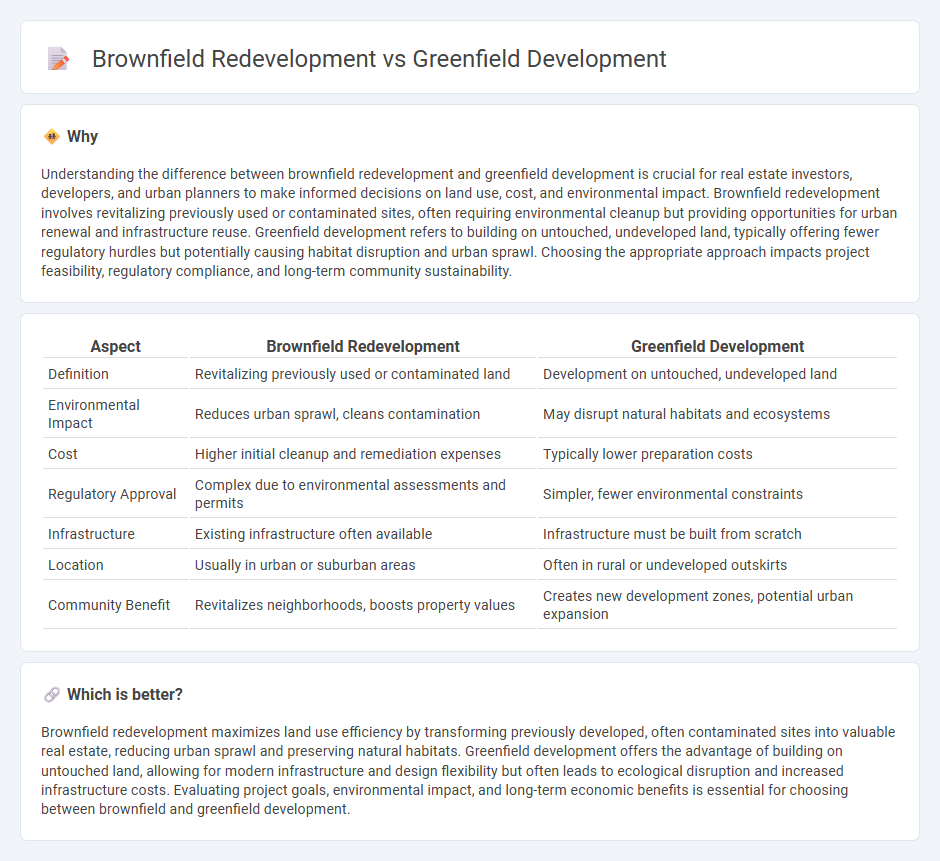
Brownfield redevelopment transforms previously industrial or contaminated sites into valuable real estate, reducing environmental hazards and revitalizing urban areas, while greenfield development focuses on building new properties on undeveloped land, often on the outskirts of cities. Brownfield projects leverage existing infrastructure and often benefit from government incentives, whereas greenfield sites offer more design flexibility but can lead to urban sprawl. Discover more about how these development strategies shape sustainable real estate growth.
Why it is important
Understanding the difference between brownfield redevelopment and greenfield development is crucial for real estate investors, developers, and urban planners to make informed decisions on land use, cost, and environmental impact. Brownfield redevelopment involves revitalizing previously used or contaminated sites, often requiring environmental cleanup but providing opportunities for urban renewal and infrastructure reuse. Greenfield development refers to building on untouched, undeveloped land, typically offering fewer regulatory hurdles but potentially causing habitat disruption and urban sprawl. Choosing the appropriate approach impacts project feasibility, regulatory compliance, and long-term community sustainability.
Comparison Table
| Aspect | Brownfield Redevelopment | Greenfield Development |
|---|---|---|
| Definition | Revitalizing previously used or contaminated land | Development on untouched, undeveloped land |
| Environmental Impact | Reduces urban sprawl, cleans contamination | May disrupt natural habitats and ecosystems |
| Cost | Higher initial cleanup and remediation expenses | Typically lower preparation costs |
| Regulatory Approval | Complex due to environmental assessments and permits | Simpler, fewer environmental constraints |
| Infrastructure | Existing infrastructure often available | Infrastructure must be built from scratch |
| Location | Usually in urban or suburban areas | Often in rural or undeveloped outskirts |
| Community Benefit | Revitalizes neighborhoods, boosts property values | Creates new development zones, potential urban expansion |
Which is better?
Brownfield redevelopment maximizes land use efficiency by transforming previously developed, often contaminated sites into valuable real estate, reducing urban sprawl and preserving natural habitats. Greenfield development offers the advantage of building on untouched land, allowing for modern infrastructure and design flexibility but often leads to ecological disruption and increased infrastructure costs. Evaluating project goals, environmental impact, and long-term economic benefits is essential for choosing between brownfield and greenfield development.
Connection
Brownfield redevelopment and greenfield development are connected by their roles in land utilization strategies addressing urban expansion and environmental sustainability. Brownfield redevelopment focuses on repurposing previously contaminated or underused urban sites, reducing the need to consume undeveloped greenfield land, thereby preserving natural habitats. This connection promotes balanced real estate growth by optimizing existing infrastructure while minimizing the environmental impact of new developments.
Key Terms
Land Use
Greenfield development involves transforming undeveloped land, typically agricultural or natural areas, into new urban or industrial projects, allowing flexible land use planning without constraints from existing infrastructure. Brownfield redevelopment focuses on rehabilitating previously used or contaminated sites, often in urban areas, which demands careful land use optimization and environmental remediation to maximize value. Explore more about how these land use strategies impact sustainable urban growth and planning.
Environmental Remediation
Greenfield development involves building on previously undeveloped land, often requiring minimal environmental remediation due to the lack of prior contamination. Brownfield redevelopment focuses on repurposing previously industrial or commercial sites, emphasizing extensive environmental remediation to address soil and groundwater pollutants. Explore the detailed processes and benefits of environmental remediation in each approach to understand their impact on sustainable urban growth.
Infrastructure Development
Greenfield development involves creating new infrastructure on previously undeveloped land, offering flexibility in design but requiring extensive investment in foundational utilities and transportation networks. Brownfield redevelopment focuses on upgrading and repurposing existing sites with established infrastructure, often reducing costs and environmental impact while addressing urban renewal challenges. Explore the benefits and specific strategies for both approaches to infrastructure development for deeper insights.
Source and External Links
A Guide to Greenfield Development (2023) - Transect - Greenfield development refers to new projects built on previously undeveloped land, offering a blank slate for developers to create infrastructure, housing, or commercial spaces without the complications of existing structures or contamination.
What Is Greenfield Development? | Planopedia - Planetizen - Greenfield development encompasses any real estate project constructed in areas that have not been previously developed, including natural open spaces and sometimes agricultural land, and is often sought for its lack of existing political and financial constraints compared to redevelopment sites.
Greenfield Development: Building from Scratch for a Sustainable Future - Greenfield development is the process of building new infrastructure or communities on unused land, typically in rural or suburban areas, allowing for innovative, sustainable design and efficient planning from the ground up.
 dowidth.com
dowidth.com